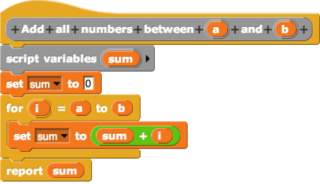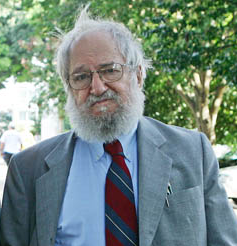Related Research Articles

Wolfram Mathematica is a software system with built-in libraries for several areas of technical computing that allow machine learning, statistics, symbolic computation, data manipulation, network analysis, time series analysis, NLP, optimization, plotting functions and various types of data, implementation of algorithms, creation of user interfaces, and interfacing with programs written in other programming languages. It was conceived by Stephen Wolfram, and is developed by Wolfram Research of Champaign, Illinois. The Wolfram Language is the programming language used in Mathematica. Mathematica 1.0 was released on June 23, 1988 in Champaign, Illinois and Santa Clara, California.

In computing, a visual programming language, also known as diagrammatic programming, graphical programming or block coding, is a programming language that lets users create programs by manipulating program elements graphically rather than by specifying them textually. A VPL allows programming with visual expressions, spatial arrangements of text and graphic symbols, used either as elements of syntax or secondary notation. For example, many VPLs are based on the idea of "boxes and arrows", where boxes or other screen objects are treated as entities, connected by arrows, lines or arcs which represent relations. VPLs are generally the basis of Low-code development platforms.

NetLogo is a programming language and integrated development environment (IDE) for agent-based modeling.

ROOT is an object-oriented computer program and library developed by CERN. It was originally designed for particle physics data analysis and contains several features specific to the field, but it is also used in other applications such as astronomy and data mining. The latest minor release is 6.28, as of 2023-02-03.

Constructionist learning is the creation by learners of mental models to understand the world around them. Constructionism advocates student-centered, discovery learning where students use what they already know to acquire more knowledge. Students learn through participation in project-based learning where they make connections between different ideas and areas of knowledge facilitated by the teacher through coaching rather than using lectures or step-by-step guidance. Further, constructionism holds that learning can happen most effectively when people are active in making tangible objects in the real world. In this sense, constructionism is connected with experiential learning and builds on Jean Piaget's epistemological theory of constructivism.

Delta3d is an open source software gaming/simulation engine API. Delta3d is managed and supported by Caper Holdings LLC. Previously the Modeling, Virtual Environments, and Simulation (MOVES) Institute at the Naval Postgraduate School in Monterey, California managed and supported delta3d. Alion Science has also been a major contributor to enhancements and features.
Sun Cloud was an on-demand cloud computing service operated by Sun Microsystems prior to Sun's acquisition by Oracle Corporation. The Sun Cloud Compute Utility provided access to a substantial computing resource over the Internet for US$1 per CPU-hour. It was launched as Sun Grid in March 2006—the same month Amazon Web Services began offering their first IT infrastructure services. It was based on and supported open source technologies such as Solaris 10, Sun Grid Engine, and the Java platform.
Web-based simulation (WBS) is the invocation of computer simulation services over the World Wide Web, specifically through a web browser. Increasingly, the web is being looked upon as an environment for providing modeling and simulation applications, and as such, is an emerging area of investigation within the simulation community.

Web Easy JavaScript Simulation , Easy JavaScript Simulations (EJSS), formerly known as Easy Java Simulations (EJS), is an open-source software tool, part of the Open Source Physics project, designed to create discrete computer simulations.

O3D is an open-source JavaScript API created by Google for creating interactive 3D graphics applications that run in a web browser window or in a XUL desktop application. O3D may be crafted for use in any application area; however, it is geared towards games, advertisements, 3D model viewers, product demos, simulations, engineering applications, control and monitoring systems, and massive online virtual worlds. O3D is currently in Google's incubation lab, and was originally built as a web browser plugin. Since 2010, O3D is a JavaScript library implemented on top of WebGL.
The following outline is provided as an overview of and topical guide to software:
References
- ↑ P Onorato and P Mascheretti and A DeAmbrosis (2012). "Investigating the magnetic interaction with Geomag and Tracker Video Analysis: static equilibrium and anharmonic dynamics". European Journal of Physics. 33 (2). IOP Publishing: 385–395. Bibcode:2012EJPh...33..385O. doi:10.1088/0143-0807/33/2/385.
- ↑ D. Brown & A. Cox, Innovative Uses of Video Analysis, The Physics Teacher 47, 145 (2009).
- ↑ J. Bryan, "Video analysis software and the investigation of the conservation of mechanical energy" Contemporary Issues in Technology and Teacher Education [Online serial], 4(3) (2004). Retrieved 1 May 2019.
- ↑ D. Brown, "Video Modeling with Tracker" Summer Meeting, American Association of Physics Teachers (2009)
- ↑ Physorg, Science Magazine Honors Web Site, retrieved 2011-12-05.
- ↑ Ars Technica, Science Education Prize Goes to Open Source Physics, retrieved 2011-12-05.
- Notes
- M. Belloni, W. Christian, and D. Brown, "Open Source Physics Curricular Material for Quantum Mechanics: Dynamics and Measurement of Quantum Two-state Superpositions," Computing in Science and Engineering 9, 4, 24-31 (2007).
- W. Christian, Open Source Physics: A User’s Guide with Examples, Addison-Wesley (2006).
- W. Christian, M. Belloni, and D. Brown, "An Open Source XML Framework for Authoring Curricular Material," Computing in Science and Engineering, September/October (2006).